Tougher Skin for Amputees
Between 2001 and the beginning of 2018, more than 1,500 U.S. military service members lost limbs in the line of duty. Although technology has improved the prosthetic devices these people can use, a stubborn obstacle remains: the fragility of human skin.
In an amputation, the skin on the residual limb is not meant to hold the pressure of a prosthesis, and it is common for painful ulcerations to develop, notes Johns Hopkins dermatologist Luis Garza.
What if there were a way to make the skin at an amputation site tougher, like the palm of your hand or the sole of your foot? Garza, who is leader of the Veteran/Amputee Skin Regeneration Program, is developing a cell therapy that could enable prosthesis wearers to use their devices longer.
“We’re taking each person’s own cells, growing them up and inserting them back in,” says Garza. “This is an example of personalized medicine.”
Garza’s postdoctoral research focused on skin stem cells. In 2009, he and his department chair, Sewon Kang, began having conversations about how that work could help the increasing numbers of veterans coming back from combat with amputations.
The program progressed to the point where Garza’s team spent the summer of 2019 testing “normal” subjects — those without amputations — to perfect the procedure, including the dose, content, method and frequency of the stem cell injections.
Garza’s team enrolled its first subject with an amputation in August. Moving from the normal population to the amputation-affected population quickly unearthed some aspects of the therapy Garza didn’t anticipate.
“When we talked with him, he said, ‘I don’t want to mess with my one remaining foot — do you have to take skin from there?’ And we said, ‘Actually, no, we could do your palm,’” says Garza. “We’re moving away from having our product informed purely by biology to letting our therapy development be shaped by the user.”
As the project enters its next phase — extension to military medical centers around the country — Garza’s team must prove that the safeguards to protect cells on their round-trip voyage from a test site to Johns Hopkins are effective and secure approval by local institutional review boards for clinical studies.
“This is game-changing technology that will have an impact for our service members, but also others who live with amputation,” says Lee Childers, senior scientist for the Extremity Trauma and Amputation Center of Excellence at Brooke Army Medical Center in San Antonio, Texas, who will lead the study there.
That population includes Americans who have undergone amputations for complications of diabetes, must use a wheelchair, or wear ankle or foot orthoses for help with walking, among others. “Having the ability to transform skin anywhere you want to target on the body will have gigantic implications across the entire spectrum of our society in many ways,” Childers says.

